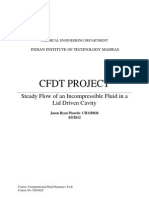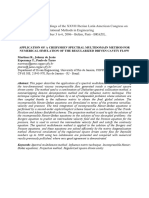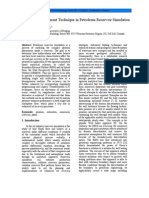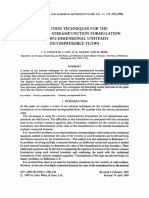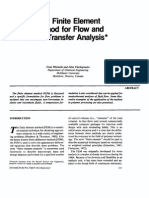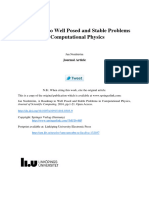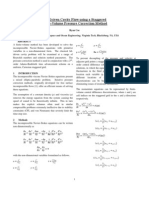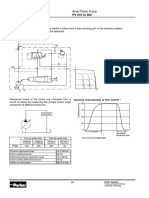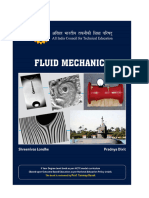Thermo Fluid
Thermo Fluid
Uploaded by
Lau YeowhongCopyright:
Available Formats
Thermo Fluid
Thermo Fluid
Uploaded by
Lau YeowhongOriginal Description:
Copyright
Available Formats
Share this document
Did you find this document useful?
Is this content inappropriate?
Copyright:
Available Formats
Thermo Fluid
Thermo Fluid
Uploaded by
Lau YeowhongCopyright:
Available Formats
Solution of thermo-uid problems
by collocation with local pressure
correction
Gregor Kosec and Bozidar S
arler
Laboratory for Multiphase Processes, University of Nova Gorica,
Nova Gorica, Slovenia
Abstract
Purpose The purpose of this paper is to explore the application of the mesh-free local radial basis
function collocation method (RBFCM) in solution of coupled heat transfer and uid-ow problems.
Design/methodology/approach The involved temperature, velocity and pressure elds are
represented on overlapping ve nodded sub-domains through collocation by using multiquadrics
radial basis functions (RBF). The involved rst and second derivatives of the elds are calculated from
the respective derivatives of the RBFs. The energy and momentum equations are solved through
explicit time stepping.
Findings The performance of the method is assessed on the classical two dimensional de Vahl
Davis steady natural convection benchmark for Rayleigh numbers from 10
3
to 10
8
and Prandtl number
0.71. The results show good agreement with other methods at a given range.
Originality/value The pressure-velocity coupling is calculated iteratively, with pressure
correction, predicted from the local mass continuity equation violation. This formulation does not
require solution of pressure Poisson or pressure correction Poisson equations and thus much simplies
the previous attempts in the eld.
Keywords Flow, Convection, Pressure, Thermodynamics, Fluid dynamics
Paper type Research paper
1. Introduction
The most commonly used discrete approximate methods for solving systems of partial
differential equations (PDEs) in uid-ow problems are the nite difference method,
the nite volume method, the nite element method, the spectral method and the
boundary element method (BEM). Despite the suitability of the enumerated methods
for solving uid ow as well as other physical situations, there are still some
substantial difculties in applying them to realistic, geometrically complex three
dimensional systems. The major problem is in creating a suitable mesh. The meshing
(polygonisation) is often the most time consuming part of the solution process and is
far from being fully automated. However, there is a rapidly emerging branch of
numerical methods, where there is no need to create a polygonisation, neither in the
domain nor on its boundary. The solution is represented on the arbitrarily distributed
set of nodes without any additional topological relations between them. These
meshfree methods represent a promising technique to avoid the meshing problems
The current issue and full text archive of this journal is available at
www.emeraldinsight.com/0961-5539.htm
The authors would like to express their gratitude to Slovenian Research Agency for support in
the framework of the projects Young Researcher Programme 1000-06-310232 (G.K.), J2-6403 and
L9-9508 (B.S
.).
HFF
18,7/8
868
Received 15 May 2007
Revised 11 December 2007
Accepted 12 December 2007
International Journal of Numerical
Methods for Heat & Fluid Flow
Vol. 18 No. 7/8, 2008
pp. 868-882
qEmerald Group Publishing Limited
0961-5539
DOI 10.1108/09615530810898999
(Atluri and Shen, 2002a, b; Atluri, 2004; Chen, 2002; Kansa, 1990a; Liu, 2003; Liu and
Gu, 2005).
Anumber of mesh-reduction techniques such as the dual reciprocity BEMwith radial
basis functions (RBF) (S
arler and Kuhn, 1999), mesh-free techniques such as the dual
reciprocity method with fundamental solutions (S
arler, 2002), meshfree local Petrov
Galerkin methods (MLPG) (Atluri and Shen, 2002b, Lin and Atluri, 2001) have been
developed for transport phenomena and solution of the Navier-Stokes equations. This
paper is focused on the simplest class of mesh-free methods in development today, the
radial basis function collocation methods (RBFCM) (Buhmann, 2000; S
arler, 2002, 2007).
The uid-ow problem is a global problem in general. In order to solve such global
problem, one needs to solve the global matrix (S
arler et al., 2004; S
arler, 2005). Solving
matrices for global systems with ne mesh or complex geometries can become a major
numerical problem, therefore completely local scheme for solving uid-ow problems
is proposed in the present paper. This method represents a local variant of the already
developed global RBFCM solution (S
arler, 2005), for coupled heat transfer and uid
ow problems. This local variant has been previously developed for diffusion
problems (S
arler and Vertnik, 2006), convection-diffusion solid-liquid phase change
problems (Vertnik and S
arler, 2006) and subsequently successfully applied in
industrial process of direct chill casting (Vertnik et al., 2006). The spectra of physics
coped is extended to solution of coupled mass, energy and momentum equations in this
paper. Instead of solving the pressure Poisson equation or/and pressure correction
Poisson equation (Divo and Kassab, 2007), a much simplied local pressure-velocity
coupling (LPVC) algorithm is proposed. The new algorithm is tested on classical de
Vahl Davis (de Vahl Davis, 1983; Hortmann et al., 1990; Manzari, 1999) natural
convection problem. The results of the method are assessed in terms of streamfunction
extreme, cavity Nusselt number, and mid-plane velocity components.
2. Governing equations
The steady-state natural convection problem is described by three coupled PDEs and
Boussinesq approximation. The PDEs are mass, momentum and energy conservation
equations where all material properties are considered to be constant. The equations
are given as:
7 v 0; 1
7 rvv 27P 7 m7v f; 2
7 rc
p
Tv 7 l7T; 3
f r1 2b
B
T 2T
ref
g; 4
with v; P; T; l; c
p
; g; r; b
B
; T
ref
; m and f standing for velocity, pressure, temperature,
thermal conductivity, specic heat, gravitational acceleration, density, coefcient of
thermal expansion, reference temperature for Boussinesq approximation, viscosity and
body force, respectively. The problem is solved on a xed domain V with boundary G
where Dirichlet and Neumann boundary conditions for temperature might be used and
Dirichlet boundary conditions for velocity are used.
Solution of
thermo-uid
problems
869
3. Solution procedure
In order to solve the problem, the time dependent variant of equations (2) and (3) is
employed. The explicit time scheme is adopted to cope with the transience terms in
momentum and energy equations. The Navier-Stokes equations (1) and (2) are solved
iteratively. The LPVC algorithm, where pressure correction is estimated from local
mass continuity violation, is used to drive the intermediate velocity towards the
divergence-free velocity. The basic elements of the solution procedure are as follows:
In the rst step, the velocity is estimated from the discretized transient form of
equation (2):
^ v v
0
Dt
r
27P
0
7 m7v
0
f
0
27 rv
0
v
0
; 5
where ^ v denotes velocity at time t
0
Dt, v
0
, P
0
denote velocity and pressure at time t
0
and Dt stands for the time-step length. The calculated velocity ^ v does not satisfy the
mass continuity equation (1) in general. In order to couple mass continuity equation
with the momentum equation, an iteration process is used where in the rst iteration,
the velocity and the pressure are set to:
v
m
^ v;
P
m
P
0
; m 1; 6
where m stands for iteration index. To project the velocity into the divergence free
space, a correction term v
^
is added:
7 v
m
v
^
0 ! 7 v
m
27 v
^
: 7
The velocity correction is assumed to be affected only by effect of the pressure
correction:
v
^
2
Dt
r
7P
^
; 8
where P
^
stands for the pressure correction. The pressure correction Poisson equation
is constructed by applying the divergence over equation (8):
7
2
P
^
r
Dt
7 v
m
: 9
Instead of solving the equation (9) globally with the appropriate pressure correction
boundary conditions (Divo and Kassab, 2007), the pressure correction is assumed to be
linearly related to the Laplace of pressure correction. In the second step, the pressure
correction is therefore calculated as:
P
^
< L
2
7
2
P
^
L
2
r
Dt
7 v
m
; 10
where L stands for characteristic length. The very important assumption (10) enables
for solving the problem completely locally. In the third step, the intermediate pressure
and velocity are corrected as:
HFF
18,7/8
870
P
m1
P
m
bP
^
;
v
m1
v
m
2b
Dt
r
7P
^
;
11
where b stands for suitable relaxation parameter. If the criteria:
7 v
m1
, 1
v
; 12
is not met than the iteration returns back to the equation (10), else the pressure-velocity
iteration is completed and the calculation proceeds to the next step.
The fourth step is to solve the transient form of the energy equation (3):
T T
0
Dt
rc
p
7 l7T
0
27 rc
p
T
0
v
0
; 13
where T
0
and T denote temperature at time t
0
and t
0
Dt. The steady-state is achieved
when the criteria:
jT2T
0
j
jT
0
j
, 1
T
; T
0
0
T , 1
T
; T
0
0
14
is met in all nodes. If the criteria (14) is not met, the body force is updated and
calculation returns back to equation (5). The simulation owchart is shown in Figure 1.
4. Radial basis function collocation method
The pressure, velocity and temperature elds are interpolated on the coincident grid
points by Hardys multiquadrics RBF. The arbitrary function u is represented on each
of the local sub-domains as:
u p <
X
N
n1
a
n
L
n
p; 15
with p; L
n
; a
n
and N standing for the position vector, the basis function, the
collocation coefcient and the number of the collocation points, respectively. Hardys
multiquadrics basis functions are dened as:
L
n
p
r
2
n
p c
2
r
2
0
q
; r
2
n
p 2p
n
p 2p
n
; 16
Figure 1.
The calculation owchart
T
0
Initial values
v
0
P
0
Apply pressure and velocity correction
Check pressure-velocity correction
convergence
Check steady-state
convergence
Time step advance
Calculate pressure correction
Solve
momentum
equation
Solve
energy
equation
P L
2
2
P = L
2
P
m+1
= P
m
+
bP
v
m+1
= v
m
b
v
m
P
t
t
r
r
Solution of
thermo-uid
problems
871
where c represents a dimensionless shape parameter. The scaling parameter r
2
0
is set to
the maximum nodal distance of the sub-domain. The coefcients a
n
are obtained from
the collocation condition which implies the exact satisfaction of the equation (15) in the
nodal points where equation (15) must hold. In case, the number of the nodes is the
same as the number of the terms in the series (15), the system simplies to:
u p
i
u
i
X
N
n1
a
n
L
n
p
i
; 17
L
11
::: L
1N
::: ::: :::
L
N1
::: L
NN
2
6
6
4
3
7
7
5
a
1
:::
a
N
2
6
6
4
3
7
7
5
u
1
:::
u
N
2
6
6
4
3
7
7
5
; 18
where L
ni
L
n
p
i
. Solution of the linear system of equation (18) provides the
collocation coefcients a
n
. Spatial derivatives of the function u can be easily obtained
through derivation of the equation (15):
p
s
u p <
X
N
n1
a
n
p
s
L
n
p; 19
2
p
s
u p <
X
N
n1
a
n
2
p
s
L
n
p; 20
where p
sx, y
stands for Cartesian coordinates. All necessary derivatives to construct
the involved divergence, gradient and Laplace operators can be calculated through
equations (19) and (20). The integral of function u over p
s
(used in the present context
in calculation of the stream function) can be evaluated as well:
Z
updp
s
X
N
n1
a
n
Z
L
n
pdp
s
: 21
All matrix elements L
ni
and coefcients a
n
need to be evaluated only once before time
stepping begins.
Only the simplest sub-domain of ve points is used within the overlapping
collocation sub-domain strategy of the present paper. The described collocation
method and sub-domain selection is schematically shown in Figure 2, where a ve
noded collocation sub-domain is used to approximate the rst and the second spatial
derivatives in the central node. The derivative instead of the function value is
prescribed at the boundary collocation points with the Neumann boundary conditions.
The equation (17) is replaced with:
p
s
up
i
X
N
n1
a
n
p
s
L
n
p
i
; 22
in such points. The index i stands for node where derivative is known.
HFF
18,7/8
872
5. Numerical examples
The classical de Vahl Davis (1983) natural convection problem is considered for
benchmarking purposes. The domain of the problem (Figure 3) is a closed air lled
(Prandtl number 0.71) square cavity with differentially heated vertical walls
DT T
H
2T
C
and insulated horizontal walls.
The steady-state is achieved through a time transient from the initial temperature,
pressure and velocity all set to zero. All results are stated in Cartesian coordinates and
standard dimensionless form (Wan et al., 2001):
x
x
L
; y
y
L
; u
uLrc
p
l
; v
vLrc
p
l
; C
T 2T
C
T
H
2T
C
;
G t
l
rc
p
L
2
;
23
where x, y stand for the dimensionless coordinates, u, v stand for the dimensionless
horizontal and vertical velocity components, C stands for the dimensionless
temperature and t stands for the dimensionless time. Prandtl and Rayleigh numbers
are calculated from the expressions:
Pr
mc
p
l
; 24
Figure 2.
Local collocation scheme
(left) and collocation
sub-domain selection
strategy (right)
Subdomain
Collocation
Boundary
Interior
Problem domain
Corner
Figure 3.
The problem description
North wall
South wall
A
B
v = 0
= 0
T
C
T
H
dT
dy
E
a
s
t
w
a
l
l
W
e
s
t
w
a
l
l
= 0
dT
dy
Solution of
thermo-uid
problems
873
Ra
gbDTL
3
r
2
c
p
lm
; 25
where DT stands for maximum temperature difference and L stands for enclosure
length.
Non-permeable and no slip (due to consideration of viscid uid) boundary
conditions are adopted on the whole boundary G:
v
G
0: 26
The results are presented in terms of stream functions and temperature contours in
Figure 4 and mid-plane velocities in Figure 5, respectively. The temperature contour
plot step is 0.05 for all cases while streamfunction contour plot step is 0.1 for Ra 10
3
,
0.5 for Ra 10
4
, 1 for Ra 10
5
and Ra 10
6
and 5 for Ra 10
7
and Ra 10
8
.
In order to enable a straightforward numerical comparison, the mid-plane velocity
values are stated in Table I, as well.
A comparison of our results (Table II) with the other similar attempts is done for the
maximum mid-plane velocities, the mid-point stream function value, and the average
Nusselt number on hot or cold wall where the results of the present study are compared
with de Vahl Davis (1983), Sadat and Couturier (2000), Wan et al. (2001) and S
arler
(2005) the streamfunction c is calculated through integration of the velocity
component:
cx; y
Z
ux; ydy: 27
The Nusselt number is calculated locally on the support of ve collocation nodes
through expression:
Nux; y 2
Cx; y
x
ux; yCx; y: 28
Our simulations are performed on 41 41 (with N
max
1,677), 81 81 (with
N
max
6,557) and 101 101 (with N
max
10,197) grid sizes, where N
max
stands for
the total number of the grid points. Additional check on the global mass
conservation of the method is done by considering the time dependent mass
continuity equation (1) globally, to check the numerical mass leakage. The following
equation is implemented:
rt Dt rt 2Dtr
0
1
N
max
X
N
max
n1
7 v
n
; rt 0 r
0
; 29
where rt stands for time dependent global density. The global density change is
introduced as:
Dr r
0
2 rN
t
Dt j j; 30
HFF
18,7/8
874
where N
t
stands for the number of time-steps. The relative density changes Dr /r
0
occurring as a function of different Rayleigh numbers for calculation with the grid
density 101 101 are stated in Table III. The time-step criteria e
T
, 10
25
is used in
all cases while pressure-velocity iteration criteria varies for different Rayleigh number
Figure 4.
Temperature contours
(solid line) and streamline
plots (dotted line)
Ra = 1.00e+003
1
0.9
0.8
0.7
0.6
0.5
0.4
0.3
0.2
0.1
0
0 0.1 0.2 0.3 0.4 0.5 0.6 0.7 0.8 0.9 1
x
y
1
0.9
0.8
0.7
0.6
0.5
0.4
0.3
0.2
0.1
0
0 0.1 0.2 0.3 0.4 0.5 0.6 0.7 0.8 0.9 1
x
y
Ra = 1.00e+004
Ra = 1.00e+005
1
0.9
0.8
0.7
0.6
0.5
0.4
0.3
0.2
0.1
0
0 0.1 0.2 0.3 0.4 0.5 0.6 0.7 0.8 0.9 1
x
y
1
0.9
0.8
0.7
0.6
0.5
0.4
0.3
0.2
0.1
0
0 0.1 0.2 0.3 0.4 0.5 0.6 0.7 0.8 0.9 1
x
y
Ra = 1.00e+006
Ra = 1.00e+007
1
0.9
0.8
0.7
0.6
0.5
0.4
0.3
0.2
0.1
0
0 0.1 0.2 0.3 0.4 0.5 0.6 0.7 0.8 0.9 1
x
y
1
0.9
0.8
0.7
0.6
0.5
0.4
0.3
0.2
0.1
0
0 0.1 0.2 0.3 0.4 0.5 0.6 0.7 0.8 0.9 1
x
y
Ra = 1.00e+008
Solution of
thermo-uid
problems
875
(Table III). The time-step varies for different Rayleigh numbers, as well. The time-steps
were determined by seeking the convergent scenario. The relaxation parameter is set to
same value as dimensionless time-step in all cases. The number of pressure-velocity
iterations, time-steps and actual calculation time for different Rayleigh numbers and
grid sizes are stated in Table III, as well. All cases are calculated with RBF shape
parameter c 30. This issue is justied by the sensitivity study, given in the
Appendix.
5.1 Numerical implementation and discussion of the results
Numerical implementation is done in C programming language in double precision
and compiled with Intel C9.1 compiler. The LAPACK routines are used to solve the
LU decomposition. The parallelisation is implemented with OpenMP library with
maximum 1.85 speedup factor achieved for two CPU cores. All calculations are done
on a laptop computer Toshiba Satellite 100, with duo core Intel 2.16 GHz processor and
1 Gb of RAM. Approximately, 1, 5 and 8 Mb of RAM storage are required for grid
densities 41 41, 81 81 and 101 101. The pressure correction requires only one
step and therefore the algorithm needs small number of calculations per iteration cycle
and this makes the algorithm fast and robust. Each pressure-velocity coupling iteration
Figure 5.
Mid-plane velocities
0 0.2 0.4 0.6 0.8 1
30
20
10
0
10
20
30
y
0 0.2 0.4 0.6 0.8 1
y
u
(
y
)
u
(
y
)
u (0.5, y) u (0.5, y)
Ra = 1.00e + 003 Pr = 0.71
Ra = 1.00e + 004 Pr = 0.71
Ra = 1.00e + 005 Pr = 0.71
200
100
0
100
200
Ra = 1.00e + 006 Pr = 0.71
Ra = 1.00e + 007 Pr = 0.71
Ra = 1.00e + 008 Pr = 0.71
Ra = 1.00e + 003 Pr = 0.71
Ra = 1.00e + 004 Pr = 0.71
Ra = 1.00e + 005 Pr = 0.71
Ra = 1.00e + 006 Pr = 0.71
Ra = 1.00e + 007 Pr = 0.71
Ra = 1.00e + 008 Pr = 0.71
0 0.2 0.4 0.6 0.8 1
60
40
20
0
20
40
60
x
v
(
x
)
v (x,0.5)
0 0.2 0.4 0.6 0.8 1
2000
1500
1000
500
0
500
1000
1500
2000
x
v
(
x
)
v (x,0.5)
HFF
18,7/8
876
x
/
y
0
.
0
0
0
0
.
0
5
0
.
1
0
.
1
5
0
.
2
0
.
2
5
0
.
3
0
.
3
5
0
.
4
0
.
4
5
0
.
5
R
a
u
0
.
0
0
0
1
.
9
2
2
3
.
0
4
2
3
.
5
7
2
3
.
6
5
5
3
.
4
2
1
2
.
9
5
8
2
.
3
3
7
1
.
6
1
1
0
.
8
2
0
0
.
0
0
0
1
0
3
v
0
.
0
0
0
2
.
0
4
4
3
.
1
8
2
3
.
6
6
9
3
.
6
8
1
3
.
3
7
7
2
.
8
6
5
2
.
2
2
6
1
.
5
1
5
0
.
7
6
5
0
.
0
0
0
u
0
.
0
0
0
8
.
8
8
4
1
4
.
0
8
4
1
6
.
3
5
8
1
6
.
4
0
6
1
4
.
9
6
1
1
2
.
5
7
5
9
.
6
6
5
6
.
5
1
1
3
.
2
6
4
0
.
0
0
0
1
0
4
v
0
.
0
0
0
1
4
.
6
8
0
1
9
.
9
2
9
1
9
.
4
1
1
1
6
.
1
1
3
1
2
.
1
9
5
8
.
6
4
7
5
.
7
6
8
3
.
5
0
3
1
.
6
4
6
0
.
0
0
0
u
0
.
0
0
0
2
0
.
2
1
8
3
2
.
1
3
3
3
5
.
3
4
0
3
1
.
8
3
9
2
5
.
0
1
8
1
7
.
7
0
4
1
1
.
4
6
2
6
.
6
9
0
3
.
0
4
8
0
.
0
0
0
1
0
5
v
0
.
0
0
0
6
7
.
7
7
8
6
0
.
0
8
8
3
3
.
2
4
5
1
3
.
2
0
1
3
.
2
6
2
2
0
.
5
2
9
2
1
.
4
5
3
2
1
.
2
2
2
2
0
.
6
7
2
0
.
0
0
0
u
0
.
0
0
0
3
4
.
5
0
4
5
8
.
0
1
2
6
6
.
5
9
4
6
0
.
4
3
3
4
6
.
7
2
9
3
2
.
2
5
6
2
0
.
2
0
8
1
1
.
3
5
6
5
.
0
0
9
0
.
0
0
0
1
0
6
v
0
.
0
0
0
2
0
9
.
7
2
9
6
5
.
5
8
7
1
.
6
3
7
2
5
.
7
7
0
2
1
.
3
9
3
0
.
7
5
3
0
.
7
8
9
0
.
5
4
5
0
.
1
7
1
0
.
0
0
0
u
0
.
0
0
0
1
1
5
.
4
7
0
1
4
9
.
6
7
0
1
2
9
.
7
9
7
6
9
.
2
5
6
3
2
.
9
8
9
3
0
.
3
0
3
3
3
.
2
0
1
2
7
.
2
5
6
1
4
.
5
1
5
0
.
0
0
0
1
0
7
v
0
.
0
0
0
2
9
4
.
7
9
6
2
1
4
.
0
0
1
2
0
.
3
9
5
0
.
0
0
4
0
.
1
7
6
0
.
3
5
7
0
.
1
0
9
0
.
4
2
3
0
.
0
0
6
0
.
0
0
0
u
0
.
0
0
0
2
4
8
.
4
5
3
2
6
6
.
3
5
4
1
4
9
.
3
0
1
8
6
.
4
1
3
9
6
.
9
8
7
9
7
.
3
1
1
7
4
.
8
1
7
4
7
.
6
0
6
2
3
.
0
6
2
0
.
0
0
0
1
0
8
v
0
.
0
0
0
7
.
7
2
6
2
0
.
9
7
3
1
.
5
6
0
2
0
.
4
1
8
0
.
3
9
2
0
.
1
5
4
2
0
.
0
1
5
0
.
1
8
6
2
0
.
0
4
1
0
.
0
0
0
Table I.
Values of mid-plane
velocity components
u and v
Solution of
thermo-uid
problems
877
takes the same order of CPU time (t
Pvi
) as the adjacent time step calculation. The time
spent for pressure correction can be estimated from t
Pvi
t
c
N
Pvi
=N
Pvi
N
t
. Good
agreement with other methods at a given range (Rayleigh number from 10
3
to 10
8
and
grid density with maximum 101 101 grid points) is achieved with the proposed
algorithm. Our method over-predicts reference results for low-Rayleigh numbers but
for higher Rayleigh numbers it under-predicts reference results. For Rayleigh number
Ra 10
3
current method over-predicts all reference results. Similar behaviour is
observed for results with Ra 10
4
, but for Ra 10
5
and Ra 10
6
our method
over-predicts only two of the three reference results. Finally, for Ra 10
7
and
Ra 10
8
current method under-predicts both comparison results. High deviance from
results (Wan et al., 2001) at a high Rayleigh number is due to grid selection. The
present results are calculated on an entirely uniform grid. The results (Wan et al., 2001)
are calculated on Gauss-Lobatto grid, which is a more suitable selection due to the
Ra v
max
y u
max
x Nu c
mid
References/discretization
10
3
3.679 0.179 3.634 0.813 1.116 1.174 de Vahl Davis (1983)
3.686 0.188 3.489 0.813 1.117 Wan et al. (2001)
3.566 3.544 1.165 S
arler (2005)
3.991 0.170 3.931 0.825 1.101 1.298 41 41
3.699 0.177 3.653 0.812 1.098 1.194 81 81
3.695 0.179 3.645 0.820 1.089 1.196 101 101
10
4
19.51 0.120 16.24 0.823 2.234 5.098 de Vahl Davis (1983)
19.79 0.120 16.17 0.823 2.243 Wan et al. (2001)
19.04 15.80 4.971 S
arler (2005)
19.81 0.120 16.24 0.825 2.075 5.155 41 41
19.83 0.120 16.27 0.825 2.120 5.167 81 81
20.03 0.120 16.45 0.830 2.258 5.240 101 101
10
5
68.22 0.066 34.81 0.855 4.510 9.142 de Vahl Davis (1983)
68.52 0.064 34.63 0.852 4.534 9.092 Sadat and Couturier (2000)
70.63 0.072 33.39 0.835 4.520 Wan et al. (2001)
67.59 32.51 8.907 S
arler (2005)
67.65 0.070 33.67 0.850 4.624 8.896 41 41
68.98 0.062 34.60 0.850 4.813 9.135 81 81
69.69 0.069 35.03 0.860 4.511 9.278 101 101
106 216.75 0.038 65.33 0.851 8.798 16.53 de Vahl Davis (1983)
219.41 0.038 64.43 0.852 8.832 16.29 Sadat and Couturier (2000)
227.11 0.04 65.4 0.86 8.8 Wan et al. (2001)
211.67 61.55 15.91 S
arler (2005)
195.98 0.045 63.73 0.850 6.1 15.15 41 41
219.48 0.038 64.87 0.851 7.67 16.13 81 81
221.37 0.039 65.91 0.860 8.97 16.51 101 101
107 687.43 0.023 145.68 0.888 16.59 28.23 Sadat and Couturier (2000)
714.48 0.022 143.56 0.922 16.65 Wan et al. (2001)
632.60 0.020 127.70 0.925 10.43 24.93 41 41
654.803 0.035 143.55 0.902 14.70 27.51 81 81
687.20 0.021 149.61 0.900 16.92 28.61 101 101
108 2180.1 0.011 319.19 0.943 30.94 50.81 Sadat and Couturier (2000)
2259.08 0.012 296.71 0.93 31.48 Wan et al. (2001)
2060.86 0.010 264.96 0.939 29.33 44.85 81 81
2095.23 0.009 278.49 0.930 32.12 47.12 101 101
Table II.
Comparison of the
present method with
previously published
results
HFF
18,7/8
878
4
1
4
1
8
1
8
1
1
0
1
1
0
1
R
a
e
v
D
t
t
c
[
s
]
N
P
v
i
N
t
D
t
t
c
[
s
]
N
P
v
i
N
t
D
t
t
c
[
s
]
N
P
v
i
N
t
D
r
/
r
1
0
3
1
0
e
2
4
1
e
2
0
4
2
0
3
,
2
0
8
2
2
,
7
5
0
1
e
2
0
4
1
9
0
2
6
,
8
3
7
2
2
,
7
5
0
5
e
2
0
5
5
2
5
3
6
6
2
4
5
5
0
0
3
.
3
7
e
2
0
0
7
1
0
4
1
0
e
2
3
1
e
2
0
4
1
5
3
,
1
5
4
1
6
,
9
4
0
1
e
2
0
4
9
2
3
,
2
5
9
1
6
,
9
4
0
5
e
2
0
5
3
9
8
3
7
0
6
3
3
8
8
0
8
.
4
4
e
2
0
0
6
1
0
5
1
0
e
2
2
1
e
2
0
4
1
2
1
,
5
9
0
1
3
,
6
9
0
1
e
2
0
4
7
0
1
,
2
4
4
1
3
,
6
9
0
5
e
2
0
5
3
2
9
4
0
9
0
2
7
3
8
0
1
.
0
6
e
2
0
0
5
1
0
6
1
1
e
2
0
4
1
1
5
,
5
2
7
1
0
,
2
0
0
1
e
2
0
4
6
6
5
,
6
0
8
1
0
,
2
0
0
1
e
2
0
5
1
4
8
6
5
5
0
4
3
1
0
2
0
0
0
1
.
3
8
e
2
0
0
4
1
0
7
5
1
e
2
0
5
1
9
1
8
,
2
5
0
1
2
,
5
0
0
1
e
2
0
5
5
1
3
7
1
,
3
4
0
6
2
,
5
0
0
5
e
2
0
6
2
5
9
7
1
8
4
6
9
7
1
2
5
0
0
0
3
.
0
1
e
2
0
0
4
1
0
8
2
5
5
e
2
0
6
1
,
2
2
5
1
9
3
,
7
0
8
1
3
5
,
0
0
0
5
e
2
0
6
2
9
3
8
2
1
9
8
8
5
1
3
5
0
0
0
5
.
9
0
e
2
0
0
4
Table III.
Pressure-velocity
iteration criteria e
v
,
time-step Dt, number of
pressure-velocity
correction iterations N
Pvi
,
number of time-steps
t
max
, actual CPU time
consumption t
c
and
global density loss Dr /r
Solution of
thermo-uid
problems
879
highest velocities in the boundary layer (Figure 5). The effect is more intense with
the higher Rayleigh numbers and so the deviance between the results grows with the
higher Rayleigh numbers.
6. Conclusions
This paper explores the local RBFCM approach in solution of the coupled heat transfer
and uid ow problems by using the simplied entirely local pressure correction. The
algorithm is very simple to implement numerically, fast and robust. The algorithm can
be efciently and straightforwardly parallelized because of its local subdomain nature
and explicit time stepping. This two important features enables the exploiting of
the full power of the multi core platforms. A remark should be made in the sense that
there are possible difculties when working with ner grids than in present paper. The
proposed algorithm includes only few surrounding points to calculate pressure
correction. The present pressure correction calculation (calculated only from closest
neighbouring points) may not be efcient enough when working with ner grids
(200 200 or ner) and high-Rayleigh numbers (more than 5 10
7
). Possible
upgrade is to include wider domain of points in the pressure correction calculation.
These topics are subject of further investigations, as well as focus on more complex
geometries and more complex physical models (porous media, solidication, . . .), which
seem to be quite simple to numerically implement in the present context. The
investigation on the adaptive time dependent grid to enhance the accuracy and to avoid
the eventual stability problems, the implementation of the characteristic-based-split
algorithm (Massarotti et al., 1998), the implementation of different sub-domain
strategies, etc. all represents open issues, connected with the present method.
References
Atluri, S.N. (2004), The Meshless Method (MLPG) for Domain and BIE Discretization, Tech
Science Press, Encino, CA.
Atluri, S.N. and Shen, S. (2002a), The Meshless Method, Tech Science Press, Encino, CA.
Atluri, S.N. and Shen, S. (2002b), The meshless local Petrov-Galerkin (MLPG) method: a simple
& less-costly alternative to the nite element and boundary element methods, Computer
Modelling in Engineering & Sciences, Vol. 3, pp. 11-52.
Buhmann, M.D. (2000), Radial Basis Functions, Cambridge University Press, Cambridge.
Chen, W. (2002), New RBF collocation schemes and kernel RBFs with applications, Lecture
Notes in Computational Science and Engineering, Vol. 26, pp. 75-86.
de Vahl Davis, G. (1983), Natural convection of air in a square cavity: a bench mark numerical
solution, International Journal of Numerical Methods in Fluids, Vol. 3, pp. 249-64.
Divo, E. and Kassab, A.J. (2007), An efcient localized RBF meshless method for uid ow and
conjugate heat transfer, ASME Journal of Heat Transfer, Vol. 129, pp. 124-36.
Hortmann, M., Peric, M. and Scheuerer, G. (1990), Finite volume multigrid prediction of laminar
natural convection bench-mark solutions, International Journal for Numerical Methods
in Fluids, Vol. 11, pp. 189-207.
Kansa, E.J. (1990a), Multiquadrics a scattered data approximation scheme with application to
computational uid dynamics, Part I, Computers and Mathematics with Applications,
Vol. 19, pp. 127-45.
HFF
18,7/8
880
Lin, H. and Atluri, S.N. (2001), Meshless local Petrov Galerkin method (MLPG) for
convection-diffusion problems, Computer Modelling in Engineering & Sciences, Vol. 1,
pp. 45-60.
Liu, G.R. (2003), Mesh Free Methods, CRC Press, Boca Raton, FL.
Liu, G.R. and Gu, Y.T. (2005), An Introduction to Meshfree Methods and Their Programming,
Springer, Dordrecht.
Manzari, M.T. (1999), An explicit nite element algorithmfor convection heat transfer problems,
International Journal of Numerical Methods for Heat and Fluid Flow, Vol. 9, pp. 860-77.
Massarotti, N., Nithiarasu, P. and Zienkiewicz, O.C. (1998), Characteristic-based-split (CBS)
algorithm for incompressible ow problems with heat transfer, International Journal of
Numerical Methods for Heat and Fluid Flow, Vol. 8, p. 969.
Sadat, H. and Couturier, S. (2000), Performance and accuracy of a meshless method for laminar
natural convection, Numerical Heat Transfer, Part B, Vol. 37.
S
arler, B. (2002), Towards a mesh-free computation of transport phenomena, Engineering
Analysis with Boundary Elements, Vol. 26, pp. 731-8.
S
arler, B. (2005), A radial basis function collocation approach in computational uid dynamics,
Computer Modelling in Engineering & Sciences, Vol. 7, pp. 185-93.
S
arler, B. (2007), From Global to Local Radial Basis Function Collocation Method for Transport
Phenomena, Springer, Berlin, pp. 257-82.
S
arler, B. and Kuhn, G. (1999), Primitive variable dual reciprocity boundary element method
solution of incompressible Navier-Stokes equations, Engineering Analysis with Boundary
Elements, Vol. 23, pp. 443-55.
S
arler, B. and Vertnik, R. (2006), Meshfree explicit local radial basis function collocation method
for diffusion problems, Computers and Mathematics with Applications, Vol. 51,
pp. 1269-82.
S
arler, B., Perko, J. and Chen, C.S. (2004), Radial basis function collocation method solution of
natural convection in porous media, International Journal of Numerical Methods for Heat
& Fluid Flow, Vol. 14, pp. 187-212.
Vertnik, R. and S
arler, B. (2006), Meshless local radial basis function collocation method for
convective-diffusive solid-liquid phase change problems, International Journal of
Numerical Methods for Heat and Fluid Flow, Vol. 16, pp. 617-40.
Vertnik, R., Zaloznik, M. and S
arler, B. (2006), Solution of transient direct-chill aluminium billet
casting problem with simultaneous material and interphase moving boundaries by a
meshless method, Engineering Analysis with Boundary Elements, Vol. 30, pp. 847-55.
Wan, D.C., Patnaik, B.S.V. and Wei, G.W. (2001), A new benchmark quality solution for the
buoyancy-driven cavity by discrete singular convolution, Numerical Heat Transfer,
Part B, Vol. 40, pp. 199-228.
Appendix. The inuence of the dimensionless shape parameter on the results
The convergence of the present RBF method was systematically studied in previous works for
diffusive and convective diffusive problems (S
arler and Vertnik, 2006; Vertnik and S
arler, 2006),
where it has been shown that the method converges.
The dimensionless shape parameter is set to 30 in all calculations in the preset paper. In order
to justify this selection, a preliminary analysis has been done, described in this Appendix. For
grid density 81 81, all cases have been recalculated with different selection of the shape
parameter. In order to measure the inuence of the shape parameter on the results, the following
deviation has been introduced:
Solution of
thermo-uid
problems
881
D
maxjvj
maxjv
120
j
A:1
where max stands for maximum and v
120
stands for velocity calculated with c 120. From
Figure A1, it is evident that c 30 represents a reasonable choice for the shape parameter in all
cases. The results are not sensitive to increase of the value of the shape parameter over 30,
however, setting high-shape parameter produces ill-conditioned matrix in equation (18). The
choice of shape parameter represents a compromise between accuracy and ill-condition of the
matrices, respectively. This behaviour has been observed also in our previous works (S
arler and
Vertnik, 2006; Vertnik and S
arler, 2006).
Corresponding author
Bozidar S
arler can be contacted at: bozidar.sarler@p-ng.si
Figure A1.
Deviation of the nal
result with respect to the
shape parameter
20 40 60 80 100 120
0.9
0.95
1
1.05
1.1
c
D
Ra = 1e3
Ra = 1e4
Ra = 1e5
Ra = 1e6
Ra = 1e7
Ra = 1e8
HFF
18,7/8
882
To purchase reprints of this article please e-mail: reprints@emeraldinsight.com
Or visit our web site for further details: www.emeraldinsight.com/reprints
You might also like
- Hydraulic Jump ExperimentDocument10 pagesHydraulic Jump ExperimentArvin De Lara Sanchez75% (4)
- Numerical Simulation of Solidification and Melting Problems Using Ansys Fluent 16.2 PDFDocument40 pagesNumerical Simulation of Solidification and Melting Problems Using Ansys Fluent 16.2 PDFAntarim Dutta50% (2)
- Lid Driven Cavity - SIMPLEDocument24 pagesLid Driven Cavity - SIMPLEJason Ryan Picardo100% (10)
- Hydraulic and Pneumatic Power SystemDocument144 pagesHydraulic and Pneumatic Power Systemali amrNo ratings yet
- Outlines Sem 7#-094 UOGDocument19 pagesOutlines Sem 7#-094 UOGadeel hassanNo ratings yet
- Application of A Chebyshev Spectral Multidomain Method For Numerical Simulation of The Regularized Driven Cavity FlowDocument15 pagesApplication of A Chebyshev Spectral Multidomain Method For Numerical Simulation of The Regularized Driven Cavity FlowJohnnyNo ratings yet
- A. Cominelli, P. Consonni, S. Mantica and G. Manzini Agip S.p.A., Milano, Italy, and CRS4, Cagliari, ItalyDocument10 pagesA. Cominelli, P. Consonni, S. Mantica and G. Manzini Agip S.p.A., Milano, Italy, and CRS4, Cagliari, Italyalberto_cominelliNo ratings yet
- Analysis and Approximation of A Vorticity-Velocity-Pressure Formulation For The Oseen EquationsDocument30 pagesAnalysis and Approximation of A Vorticity-Velocity-Pressure Formulation For The Oseen EquationsYuliza Carolina Capuñay SiesquénNo ratings yet
- High-Order Finite Difference Schemes For Incompressible FlowsDocument24 pagesHigh-Order Finite Difference Schemes For Incompressible Flowslalrajnesh1102No ratings yet
- J-HXfer Meshless ConjugateDocument13 pagesJ-HXfer Meshless Conjugatebardock277No ratings yet
- Boundary Element Technique in Petroleum Reservoir SimulationDocument8 pagesBoundary Element Technique in Petroleum Reservoir Simulationiky77No ratings yet
- Adaptive Simulations of Two-Phase Ow by Discontinuous Galerkin MethodsDocument16 pagesAdaptive Simulations of Two-Phase Ow by Discontinuous Galerkin MethodsJesse ClarkNo ratings yet
- UNIT NO 1: Finite Difference SchemesDocument9 pagesUNIT NO 1: Finite Difference SchemesAbhishek SaxenaNo ratings yet
- Computer Application On Well Test Mathematical Model Computation of Homogenous and Multiple-Bounded ReservoirsDocument12 pagesComputer Application On Well Test Mathematical Model Computation of Homogenous and Multiple-Bounded Reservoirstsar_philip2010No ratings yet
- Aeroelasticity Calculations Using A Finite Element Method: 2.1. Fluid AnalysisDocument7 pagesAeroelasticity Calculations Using A Finite Element Method: 2.1. Fluid Analysisr1733No ratings yet
- Solution Techniques For The Vorticity-Streamfunction Formulation O F Two-Dimensional Unsteady Incompressible FlowsDocument25 pagesSolution Techniques For The Vorticity-Streamfunction Formulation O F Two-Dimensional Unsteady Incompressible FlowsIshwar SinghNo ratings yet
- YeckelA&DerbyJJ 1999 PressureDatumForIncompFlowsDocument16 pagesYeckelA&DerbyJJ 1999 PressureDatumForIncompFlowsjadamiatNo ratings yet
- 11 - An Implicit Mixed Enthalpy Temperature Method For Phase Change ProblemsDocument9 pages11 - An Implicit Mixed Enthalpy Temperature Method For Phase Change ProblemsLucas SantosNo ratings yet
- Fan 1999Document24 pagesFan 1999Pratyush MohantyNo ratings yet
- Michelsen The Isothermal Flash Problem 2 PhasDocument20 pagesMichelsen The Isothermal Flash Problem 2 Phasgggggg82No ratings yet
- Finite Element Moving Mesh Analysis of Phase Change Problems With Natural ConvectionDocument16 pagesFinite Element Moving Mesh Analysis of Phase Change Problems With Natural ConvectionchrissbansNo ratings yet
- A Hybrid Pressure-Density-Based Algorithm For The Euler Equations at All Mach Number RegimesDocument16 pagesA Hybrid Pressure-Density-Based Algorithm For The Euler Equations at All Mach Number RegimesAnonymous SlyvspdBNo ratings yet
- Numerical Simulation of Two-Phase Flow Through Heterogeneous Porous MediaDocument9 pagesNumerical Simulation of Two-Phase Flow Through Heterogeneous Porous MediaAnibal Coronel PerezNo ratings yet
- Chapter 7 7.1Document15 pagesChapter 7 7.152tm6xdqpwNo ratings yet
- Mixed Analytical/numerical Method Applied To The Low Reynolds Number K-Epsilon Turbulence ModelDocument8 pagesMixed Analytical/numerical Method Applied To The Low Reynolds Number K-Epsilon Turbulence ModelmojiryhamidNo ratings yet
- An Exact Analytical Solution of The Reynolds Equation For The Finite JournalDocument13 pagesAn Exact Analytical Solution of The Reynolds Equation For The Finite JournalMourad TargaouiNo ratings yet
- wave 1Document27 pageswave 1kedirNo ratings yet
- A Fully Coupled Finite Volume Solver For The Solution of Incompressible Flows On Locally Refined Non-Matching Block-Structured GridsDocument12 pagesA Fully Coupled Finite Volume Solver For The Solution of Incompressible Flows On Locally Refined Non-Matching Block-Structured GridsErnesto Delfino AguirreNo ratings yet
- The Finite Element Method For Flow and Heat Transfer AnalysisDocument15 pagesThe Finite Element Method For Flow and Heat Transfer AnalysisShimaa BarakatNo ratings yet
- Art19 Modelo Ede EspesadorDocument32 pagesArt19 Modelo Ede EspesadorCarlos de la TorreNo ratings yet
- Low Mach Number ApproximationDocument42 pagesLow Mach Number ApproximationDiana MitroiNo ratings yet
- Kedir aliyi KorocheDocument19 pagesKedir aliyi KorochekedirNo ratings yet
- Kedir IndiaDocument26 pagesKedir IndiakedirNo ratings yet
- A Finite-Volume Algorithm For All Speed FlowsDocument8 pagesA Finite-Volume Algorithm For All Speed Flowsles_lesNo ratings yet
- 10 1002@sici1097-02071996011539@1115@@aid-Nme8523 0 Co2-D PDFDocument25 pages10 1002@sici1097-02071996011539@1115@@aid-Nme8523 0 Co2-D PDFMateus Costa PinheiroNo ratings yet
- Numerical Simulation of The Dam Break Problem by General Natural Element Method KemerovoDocument4 pagesNumerical Simulation of The Dam Break Problem by General Natural Element Method KemerovoEndless LoveNo ratings yet
- ThermoDocument8 pagesThermoLau YeowhongNo ratings yet
- Rapid Crack Propagation in Plastic Pipe: Predicting Full-Scale Critical Pressure From S4 Test ResultsDocument16 pagesRapid Crack Propagation in Plastic Pipe: Predicting Full-Scale Critical Pressure From S4 Test ResultsE.s. BinbillahNo ratings yet
- Density Variation in Finite Volume SchemesDocument5 pagesDensity Variation in Finite Volume Schemeshhqq2010No ratings yet
- Benchmark Va HL Davis 83 BDocument22 pagesBenchmark Va HL Davis 83 Bjmms21No ratings yet
- Kedir PRADI_Advection_diffusionDocument15 pagesKedir PRADI_Advection_diffusionkedirNo ratings yet
- FluidMechanics7thEditionbyFrankM WhiteDocument7 pagesFluidMechanics7thEditionbyFrankM Whitebitan royNo ratings yet
- The Isothermal Flash Problem Part 1 Stability M.MichelsenDocument20 pagesThe Isothermal Flash Problem Part 1 Stability M.MichelsenJose EduardoNo ratings yet
- Modified Fractional-Step Methods For The Navier-Stokes EquationsDocument14 pagesModified Fractional-Step Methods For The Navier-Stokes EquationsWaqas Bin FaatehNo ratings yet
- KK Sir 8Document7 pagesKK Sir 8harshalsparksNo ratings yet
- Numerical Simulation of Coupled Uid Solid Problems: Michael SCH Afer, Ilka TeschauerDocument23 pagesNumerical Simulation of Coupled Uid Solid Problems: Michael SCH Afer, Ilka TeschauerBahadır HarmancıNo ratings yet
- Multi Scale Mixed Finite Element Modeling of Coupled Wellbore Near-Well FlowDocument9 pagesMulti Scale Mixed Finite Element Modeling of Coupled Wellbore Near-Well Flowpetar_damyanovNo ratings yet
- 337 345 PDFDocument9 pages337 345 PDFHamid MojiryNo ratings yet
- PhysRevE 87 030101Document4 pagesPhysRevE 87 030101Rajneesh PerhateNo ratings yet
- FULLTEXT01Document22 pagesFULLTEXT01andresNo ratings yet
- Analysis of Flow of Viscous Fluids by The Finite-Element MethodDocument10 pagesAnalysis of Flow of Viscous Fluids by The Finite-Element MethodPeri Pitriadi CaralozNo ratings yet
- Parameter-Robust Preconditioners For Biot's ModelDocument30 pagesParameter-Robust Preconditioners For Biot's ModelAxel DorianNo ratings yet
- Benchmark Va HL Davis 83Document16 pagesBenchmark Va HL Davis 83jmms21No ratings yet
- Efficient Numerical Method For Computation of Thermohydrodynamics of Laminar Lubricating FilmsDocument25 pagesEfficient Numerical Method For Computation of Thermohydrodynamics of Laminar Lubricating FilmsHamid MojiryNo ratings yet
- Using Comsol Multiphysics To Model Viscoelastic Fluid FlowDocument9 pagesUsing Comsol Multiphysics To Model Viscoelastic Fluid FlowBao KimNo ratings yet
- A Numerical Solution of The Navier-Stokes Equations Using The Finite ElementDocument28 pagesA Numerical Solution of The Navier-Stokes Equations Using The Finite ElementSatyen RamaniNo ratings yet
- Portuguese 219 ReviewDocument3 pagesPortuguese 219 ReviewDanica PomperadaNo ratings yet
- Progress in Electromagnetics Research, Vol. 123, 227-241, 2012Document15 pagesProgress in Electromagnetics Research, Vol. 123, 227-241, 2012rashidshahzadawanNo ratings yet
- Key Words and Phrases. Inverse Heat Conduction Problem, Fundamental Solution MethodDocument21 pagesKey Words and Phrases. Inverse Heat Conduction Problem, Fundamental Solution MethodFahad AlmafakirNo ratings yet
- Lid Driven FlowDocument8 pagesLid Driven Flowmanoj0071991No ratings yet
- Level Set Method: Advancing Computer Vision, Exploring the Level Set MethodFrom EverandLevel Set Method: Advancing Computer Vision, Exploring the Level Set MethodNo ratings yet
- Assignment2 PDFDocument1 pageAssignment2 PDFLau YeowhongNo ratings yet
- Adaptive Control System MRAC Also Known As MIT Rule Which Is A Very Fundamental For Control EngineeringDocument1 pageAdaptive Control System MRAC Also Known As MIT Rule Which Is A Very Fundamental For Control EngineeringLau YeowhongNo ratings yet
- AssignmentDocument1 pageAssignmentLau YeowhongNo ratings yet
- Assignment: Submit Before 4:00 PM, 26 May 2016Document1 pageAssignment: Submit Before 4:00 PM, 26 May 2016Lau YeowhongNo ratings yet
- DH 1Document3 pagesDH 1Lau YeowhongNo ratings yet
- DH 2Document3 pagesDH 2Lau YeowhongNo ratings yet
- Becker, Ronald M. - Lean Manufacturing and The Toyota Production System (2007, Lean Management Instituut, 3p)Document3 pagesBecker, Ronald M. - Lean Manufacturing and The Toyota Production System (2007, Lean Management Instituut, 3p)Sergio BoillosNo ratings yet
- Analyzing and Evaluating Critically Tesco's Current OperationsDocument4 pagesAnalyzing and Evaluating Critically Tesco's Current OperationsLau Yeowhong100% (1)
- Exercise Magnetic CircuitDocument10 pagesExercise Magnetic CircuitLau YeowhongNo ratings yet
- Linear Programming and Lean ManufacturingDocument8 pagesLinear Programming and Lean ManufacturingLau YeowhongNo ratings yet
- Automotive MechatronicsDocument9 pagesAutomotive MechatronicsLau YeowhongNo ratings yet
- Thermofluid Characteristics of Frosted Finned-Tube Heat ExchangersDocument8 pagesThermofluid Characteristics of Frosted Finned-Tube Heat ExchangersLau YeowhongNo ratings yet
- Computers & Fluids: Y. Wang, C. Shu, C.J. TeoDocument14 pagesComputers & Fluids: Y. Wang, C. Shu, C.J. TeoLau YeowhongNo ratings yet
- Hierarchical Design Models in The Mechatronic ProductDocument12 pagesHierarchical Design Models in The Mechatronic ProductLau Yeowhong100% (1)
- PV 016 To 360 Load Sensing Control Load Sensing Controls: Axial Piston PumpDocument1 pagePV 016 To 360 Load Sensing Control Load Sensing Controls: Axial Piston PumpgnowasNo ratings yet
- Particle Size Measurement Volume 2Document256 pagesParticle Size Measurement Volume 2fateme292100% (4)
- Fluent-Intro 16.0 L07 TurbulenceDocument50 pagesFluent-Intro 16.0 L07 Turbulenceghoshna jyotiNo ratings yet
- Head CalculationDocument8 pagesHead CalculationTariq AsgharNo ratings yet
- All About ValvesDocument39 pagesAll About ValvesKarthik Naidu100% (1)
- Sheet 1Document11 pagesSheet 1lawanNo ratings yet
- Spillways and Energy DissipatorsDocument39 pagesSpillways and Energy DissipatorsBenson NkyaNo ratings yet
- Experimental Research On Heat Transfer Characteristics of Helical Coil Heat Exchanger With Varying Pitch For Laminar Fluid FlowDocument6 pagesExperimental Research On Heat Transfer Characteristics of Helical Coil Heat Exchanger With Varying Pitch For Laminar Fluid FlowMadhu ReddyNo ratings yet
- WindDocument6 pagesWindMark Kenneth BaldoqueNo ratings yet
- Restriction Orifice RO Flow Control InstrumentDocument3 pagesRestriction Orifice RO Flow Control Instrumentmsr22No ratings yet
- High DP Orifice FlowDocument2 pagesHigh DP Orifice FlowtibitomicNo ratings yet
- Boundary Layer Theory Lecture 2 - 2024Document24 pagesBoundary Layer Theory Lecture 2 - 2024rishNo ratings yet
- DTIC ADA395503 Summary of Drag Coefficients of Various Shaped CylindersDocument51 pagesDTIC ADA395503 Summary of Drag Coefficients of Various Shaped CylindersBuican GeorgeNo ratings yet
- Choked FlowDocument6 pagesChoked FlowAntonio MezzopreteNo ratings yet
- 320D & 320D L Excavator Hydraulic System Schematic PDFDocument2 pages320D & 320D L Excavator Hydraulic System Schematic PDFchanlin100% (5)
- Lec-6 - Kinematics of FlowDocument26 pagesLec-6 - Kinematics of Flowwww.muhammadshahzaib72No ratings yet
- Internal Corrosion Direct Assessment For Dry Gas & Multiphase Pipelines Using Corrosion Prediction ModelsDocument20 pagesInternal Corrosion Direct Assessment For Dry Gas & Multiphase Pipelines Using Corrosion Prediction Modelspapaya123No ratings yet
- PRV DRV RangeDocument7 pagesPRV DRV RangeSharon LambertNo ratings yet
- Homework: Ideal FlowsDocument15 pagesHomework: Ideal Flowsgaldo2No ratings yet
- Thermodynamics Concepts and Applications 1st Edition Stephen R. Turns 2024 Scribd DownloadDocument51 pagesThermodynamics Concepts and Applications 1st Edition Stephen R. Turns 2024 Scribd Downloadgyasienzoji100% (1)
- Thrust Equation For A Turbojet Single Inlet/Outlet: Joshtheengineer April 7, 2017Document5 pagesThrust Equation For A Turbojet Single Inlet/Outlet: Joshtheengineer April 7, 2017pfylNo ratings yet
- Hyd RexDocument2 pagesHyd RexMohamed ElmakkyNo ratings yet
- TRANSPORT PHENOMENA - Unit 1 NotesDocument150 pagesTRANSPORT PHENOMENA - Unit 1 NotesRathi ManiNo ratings yet
- Darcy Friction Loss Calculator For Pipes, Fittings & Valves: Given DataDocument2 pagesDarcy Friction Loss Calculator For Pipes, Fittings & Valves: Given DatachoopoNo ratings yet
- Fluid MechanicsDocument356 pagesFluid MechanicsMahesh N JethvaNo ratings yet
- IC8251Document1 pageIC8251Saravanan MathiNo ratings yet
- Macrosegregation PDFDocument6 pagesMacrosegregation PDFZakaria AguezzarNo ratings yet


